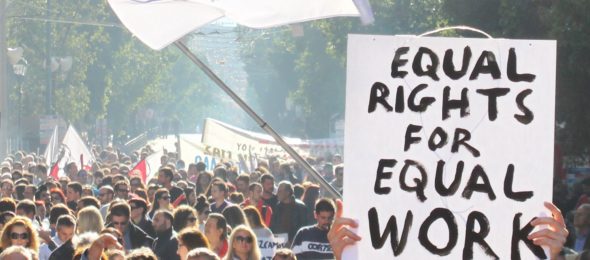International Women’s Day 2020: The every day of women’s day
Here’s to 45 years of celebrating women’s day where we call for gender equality on one day and then get back to the routine life the other 364 days of the year, and women are far, too far from anything resembling parity with men in any field.
Celebrated each year on March 8, the idea behind International Women’s Day is to celebrate women’s achievements – from political to social- while calling for gender equality. It was in 1975 that the United Nations recognised this day and ever since it has created a theme each year for the celebration. The theme of this year is “I am Generation Equality: Realising Women’s Rights”.
However, now in its 45th year, if the UN officials looked back over the years, not much has moved for women in this world. Their position in the society – be it developed or developing, educated or not, following any religion or none – has remained pretty much static.
Start with an important aspect, that is women as leaders. Several developed countries have advocated about women’s leadership in political decision-making processes. Starting with the United States that is yet to elect a female President, a large number of OECD countries, the most developed economies in the world, have never had a woman as head of government. And the gap remains wide even in the lower echelons of politics. According to data by UN Women, the United Nations entity dedicated to gender equality and the women empowerment, women are still way behind men in leadership positions from community to global levels. As of January 2019, only 20.7 pc of government ministers were women and only 24.3 pc of all national parliamentarians were women as of February 2019, a slow increase from 11.3 pc in 1995. Globally, there are 27 States in which women account for less than 10 pc of parliamentarians in single or lower houses, as of February 2019, including three chambers with no women at all. In 103 countries and areas women’s representation in elected local deliberative bodies varied from less than one percent to close to parity, at 50 pc, with a median of 26 pc. In India itself, nine out of 10 legislators are men. As of 2014, women make up only 11.8 pc of the Indian Lok Sabha and 11.4 pc of the Indian Rajya Sabha, according to the Inter-Parliamentary Union.
Not just in the political arena but across all levels of India’s public service, women’s representation is low. Only 23 pc of the Indian Administrative Service, 12 pc of the current Lok Sabha and 11 pc of Supreme Court judges are women. According to a 2017 report by the World Economic Forum, it could still take another 100 years before the global equality gap between men and women disappears entirely.
The wage gap
Another important element where women are estimated to match up to the level of men in around 257 years is the wage gap. According to the World Economic Forum, on an average, women across the world are paid just 63 pc of what men earn. There is not a single country where women are paid as much as men. “In the workplace, women still encounter significant obstacles in taking on managerial or senior official roles,” the report said. “When we consider only managers for the subset of countries for which recent data are available, just about 34 pc of global managers are women.”
As per the World Economic Forum’s Global Gender Gap Report 2020, out of the 153 countries studied for the report, India ranks 112th on the overall Global Gender Gap Index.
Not only is there the problem of wage gap but that of unpaid work too. Women and girls, in poverty and from marginalised groups, spend 12.5 billion hours every day caring for others for free. According to Oxfam, a charity, this work adds at least USD 10.8 trillion in economic value a year, three times greater than the tech industry. Women around the globe, particularly those who live in poverty, do more than 75 pc of all unpaid care work.
Worldwide, an estimated 606 million women, or 41 pc of those currently unemployed, are excluded from the labour market because of family responsibilities. Even when women do work, they are often trapped in informal, low-paid jobs with flexible hours that allow for a second, unpaid day at home.
The total wealth of 63 billionaire men in India is more than India’s 2019 Union Budget. Women and girls in India put in 3.26 billion hours of unpaid care work every day — an annual contribution of INR 19 trillion to the Indian economy, 20 times India’s 2019 education budget of INR 930 billion.
Not just the wage gap but the number of women in top business roles is still low. Despite all the talk around gender diversity and affirmative action, women are still lesser in number when it comes to taking top positions in the corporate sector. For example in the US, only five percent of CEOs of major corporations are women. According to WEF, the greatest challenge preventing the economic gender gap from closing is women’s under-representation in emerging roles. Just 12 pc women professionals are involved in cloud computing, 15 pc in engineering and 26 pc are there in Data and AI.
Analysis from Cranfield University, as part of its 20th FTSE Women on Boards Report, shows a sharp drop in the number of women occupying chief executive (CEO), chief financial officer (CFO) or other executive roles on FTSE 250 boards, and static numbers at FTSE 100 companies.
Similarly, corporate India has failed to bring more women into leadership positions in recent times. Out of every 100 CEOs and managing directors of companies listed on the National Stock Exchange, only about three are women, and this has been the case since 2014. Out of 1,814 chief executives and MDs of NSE-listed companies, only 67, or 3.69 pc are women as of March 6, 2019, as per latest data from Prime Database. This shows that the percentage of women CEOs/MDs has remained almost stagnant since March 2014 when out of 1,249 CEOs/MDs, 40, or 3.2 pc, were women.
Women in defence
In a world where women are constantly fighting a social battle they are mostly barred from the battles on borders. The recent case of India is a classic example. In a statement to the apex Court, countering grant of command to women officers, the Indian army stated, “Women may not be suitable for commanding roles in the Indian Army as male troops are not prepared to accept women officers.” The statement added, “The composition of rank and file being male, and predominantly drawn from rural background, with prevailing societal norms, the troops are not yet mentally schooled to accept women officers in command.”
The Indian Army inducted 364 women officers in 2019, as compared to 819 in 2018, minister of state for defence Shripad Naik said on March 2, 2019. In a written reply to a question in the Rajya Sabha, Naik stated that the Indian Air Force inducted 51 women officers in 2019, as compared to 59 in 2018. The Air Force figure does not include women officers in medical and dental branches, he said.
In America there are approximately 200,000 women on active duty in the US armed forces. They constitute nearly 20 pc of its strength. Similarly in Britain, out of the total strength of 196,650 of the Navy, Army and Air Force, women number 17,900 (3,670 officers and 14,230 other ranks). Thus they constitute 9.1 pc of the total strength, 11.2 pc of the officer cadre and 8.7 pc of the other ranks. However, in India, across the army, navy and air force, there were only 3,653 women compared to 62,507 men in 2018, according to the latest data. In terms of gender ratios, the air force has the best gender balance, but men still constitute seven times the cadre. In the army, the ratio is worse: there are 27 men per woman.
However, in the developed nations too women are not considered to be strong enough for combat roles. Estimates from the North Atlantic Treaty Organization (NATO) show that women do not contribute significantly to the combat forces of NATO militaries. In 2017, less than a fifth of all NATO active military duty personnel were women with Hungary, the US and Canada having the highest female representation.
Violence against women
Even though the Indian government has launched several schemes for women’s empowerment like the Pradhan Mantri Ujjwala Yojana, Beti Bachao Beti Padhao, Ladli Yojana, Digital Laado and many more, there is hardly any improvement in the status of women. A 2018 report by the National Commission for Protection of Child Rights found that of the 40-odd pc of girls in the 15-18 age group who were out of school in India, almost 65 pc was engaged in household work.
Women and girls are underpaid and employed in unskilled jobs as well as part-time or flexible jobs which offer little social security. They are often concentrated in low-paying, care-giving jobs such as teaching, domestic work and healthcare and are paid less than a living wage.
Not only are the women subjected to discrimination outside their houses but inside as well. As per World Bank data gender-based violence (GBV) or violence against women and girls (VAWG), is a global pandemic that affects one in three women in their lifetime. As much as 35 pc of women worldwide have experienced either physical and/or sexual intimate partner violence or non-partner sexual violence. Globally, seven percent of women have been sexually assaulted by someone other than a partner.
Women face violence in many different forms, including domestic violence, sexual assault and harassment, child, early and forced marriage, sex trafficking, so called ‘honour’ crimes and female genital mutilation. It is not because of any kind of technological error but is more of a human error. Men refuse to allow women to take on important positions in any field and consider her to be the inferior sex. Women face gender inequality throughout their lives, beginning right from childhood and continuing till old age.
So, on this International Women’s Day in the year 2020, the UN and indeed the rest of the world could do better than simply pay lip service to a cause that concerns half of the world’s population and ensure that the issues concerning women become an everyday topic, rather than something to be evoked on March 8 every year for the next 45 editions of IWD.










